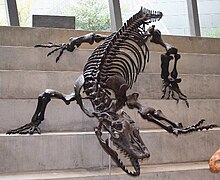Megalania
| Megalania Temporal range: , 1.5–0.04 Ma |
|
|---|---|
 |
|
| Megalania skeletal reconstruction on Melbourne Museum steps | |
| Scientific classification | |
| Kingdom: | Animalia |
| Phylum: | Chordata |
| Class: | Reptilia |
| Order: | Squamata |
| Family: | Varanidae |
| Genus: | ?Megalania (see text) |
| Species: | ?M. prisca (see text) |
| Proposed binomials | |
|
Designation is controversial: EitherorMegalania prisca Owen, 1859 orEitherVaranus priscus (Owen, 1859) |
|
Designation is controversial: EitherorMegalania prisca Owen, 1859 orEitherVaranus priscus (Owen, 1859)
Megalania (Megalania prisca or Varanus priscus) is an extinct giant goanna or monitor lizard. They were part of a megafaunal assemblage that inhabited southern Australia during the . The youngest fossil remains date to around 50,000 years ago. The first aboriginal settlers of Australia might have encountered them.
The name Megalania prisca was coined in 1859 by Sir Richard Owen to mean "ancient great roamer"; the name was chosen "in reference to the terrestrial nature of the great Saurian". Owen used a modification of the Greek word ἠλαίνω ēlainō ("I roam"). The close similarity to the Latin word: lania (feminine form of "butcher") has resulted in numerous taxonomic and popular descriptions of megalania mistranslating the name as: ancient giant butcher.
Owen introduced the genus Megalania to accommodate the species Megalania prisca. Its status as a valid genus remains controversial, with many authors preferring to consider it a junior synonym of Varanus, which encompasses all living monitor lizards. As the gender of the genera Megalania and Varanus are respectively feminine and masculine, the specific name prisca (fem.)/priscus (masc.) follows suit.
The genus Megalania is included as a synonym of Varanus by many researchers due to the relationships of the many Varanus species; M. prisca is closely related to other Australian monitors classified as Varanus, so excluding M. prisca from Varanus renders the latter genus an unnatural grouping. Ralph Molnar noted in 2004 that, even if every species of the genus Varanus were divided into groups currently designated as subgenera, V. priscus would still be classified in the genus Varanus, because this is the current subgenus name, as well as genus name, for all Australian monitors. Unless other Australian monitor species were each also classified their own exclusive genera, Megalania would not be a valid genus name. However, Molnar noted that "megalania" is suitable for use as a vernacular, rather than scientific name, for the species Varanus priscus.
...
Wikipedia
